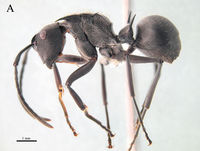Polyrhachis doudou
| Polyrhachis doudou | |
|---|---|

| |
| Scientific classification | |
| Kingdom: | Animalia |
| Phylum: | Arthropoda |
| Class: | Insecta |
| Order: | Hymenoptera |
| Family: | Formicidae |
| Subfamily: | Formicinae |
| Tribe: | Camponotini |
| Genus: | Polyrhachis |
| Subgenus: | Myrma |
| Species group: | militaris |
| Species: | P. doudou |
| Binomial name | |
| Polyrhachis doudou Rigato, 2016 | |
The type material was collected by sweeping in the undergrowth of coastal lowland rainforest.
Identification
Rigato (2016) - A moderately large species in the militaris group, with somewhat rectangular head, appendages without standing hairs, and moderately abundant short greyish pubescence.
Polyrhachis doudou shares with Polyrhachis militaris the subrectangular head outline in full face view. In addition, P. doudou recalls the less brightly coloured militaris specimens coated with short pubescence, and main differences between doudou and militaris are summarized in the key. Because of its size and colour P. doudou looks similar to Polyrhachis schistacea, but the latter has hairy appendages, rounded head and, usually, a lower SI.
Keys including this Species
Distribution
Distribution based on Regional Taxon Lists
Afrotropical Region: Gabon (type locality).
Distribution based on AntMaps
Distribution based on AntWeb specimens
Check data from AntWeb
Countries Occupied
| Number of countries occupied by this species based on AntWiki Regional Taxon Lists. In general, fewer countries occupied indicates a narrower range, while more countries indicates a more widespread species. |

|
Estimated Abundance
| Relative abundance based on number of AntMaps records per species (this species within the purple bar). Fewer records (to the left) indicates a less abundant/encountered species while more records (to the right) indicates more abundant/encountered species. |

|
Biology
Castes
Nomenclature
The following information is derived from Barry Bolton's Online Catalogue of the Ants of the World.
- doudou. Polyrhachis doudou Rigato, 2016: 14, figs. 2a-c (w.) GABON.
Unless otherwise noted the text for the remainder of this section is reported from the publication that includes the original description.
Description
Worker
Holotype. HL 2.14, HW 1.60, CI 75, SL 2.93, SI 183, FW 0.55, FI 34, PW 1.43, WL 3.03, HTL 2.93.
Clypeus faintly carinate medially, anterior clypeal margin evenly convex. Head in full face view subrectangular with weakly convex sides, broadly rounded posterior corners and slightly medially protruding occiput. Eyes moderately convex, placed relatively posteriorly; behind each eye a very blunt margination separates the head dorsum from the side. Scapes long and thin. Mesosoma moderately stout, in profile forming a broad curvature interrupted at the sutures, of which the metanotal one is the most impressed; all mesosoma segments look flat transversely. Mesonotum twice as wide as long, propodeal dorsum as wide as long. In profile, propodeal dorsum and declivity similar in length. Pronotal spines long, moderately anteriorly divergent and thin. Mesosoma distinctly marginate along its sides, the marginations mostly forming narrow flanges interrupted at the sutures. Propodeal dorsum and declivity separated by a sudden change of sculpturation. Propodeal teeth small and upturned. Petiole bearing a mid pair of long, erect, well separated and moderately divergent spines, and a lateral pair of small sharp teeth, close to the base of the spines. In frontal view petiole flat between the spines. First gastral tergite anteriorly shallowly concave.
Mandibles finely longitudinally striolate and with sparse, small piligerous pits. Clypeus finely reticulatepunctate with sparse rough puncturation giving a scabrous appearance, especially laterally. Most of head dorsum and mesosoma, including the sides, finely and almost regularly longitudinally rugulose, with a finely reticulatepunctate ground sculpture. Propodeal declivity finely reticulate-imbricate. Petiole, gaster and appendages finely reticulate-punctate. The whole body looks dull and with a cinder-like reflection.
Standing, yellowish/whitish hairs moderately abundant and long on the occiput, dorsum of mesosoma and gaster; shorter and more scattered hairs on frons and clypeus. Head sides in front of the eyes, ventral head surface, petiole and appendages without standing hairs, the whole body and appendages covered with relatively dense, but short, whitish pubescence; longer on mesosomal sides and petiole; denser and shorter on gaster and, especially, appendages.
Colour black throughout, including mandibles, funiculi and tarsi.
Paratypes. (n=2). HL 2.21–2.29, HW 1.63–1.70, CI 74, SL 2.93–2.97, SI 172–182, FW 0.55–0.56, FI 33–34, PW 1.40–1.52, WL 3.00–3.17, HTL 2.98–3.07. Not significantly different from the holotype.
Type Material
Holotype worker. GABON: Prov. Ogoové-Maritime, Réserve des Monts Doudou, 25.2 km 304° NW Doussala, 2°13.63’S 10°23.67’E, 600 m, 15.iii.2000 (S. van Noort), sweep, coastal lowland rainforest, undergrowth, low canopy in forest (California Academy of Sciences: GA00 S104-1). Paratypes. same data as the holotype (1 w, CAS: GA00 S103-1); GABON: Prov. Ogoové-Maritime, Réserve des Monts Doudou, 24.3 km 307° NW Doussala, 2°13.35’S 10°24.35’E, 370 m, 10.iii.2000 (S. van Noort), sweep, coastal lowland rainforest, undergrowth, low canopy in forest (1 w, CAS: GA00 S83-9).

